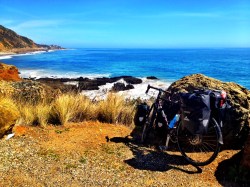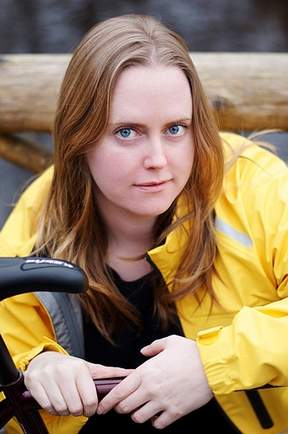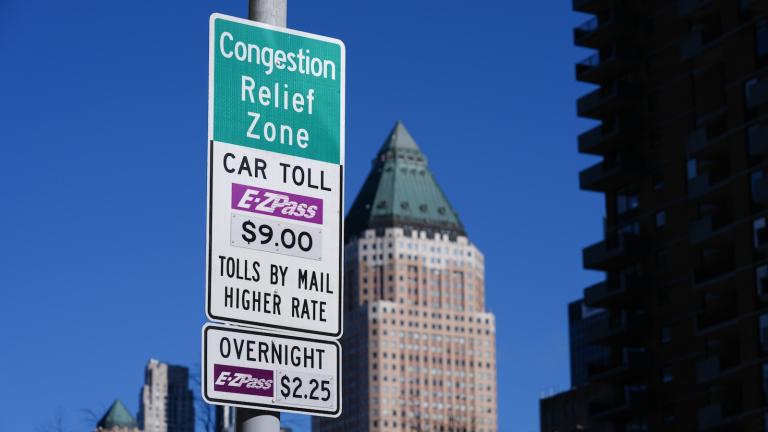
Naomi Devine. (Photo by Zoma Fotografia.)
Thousands of people from around the world have converged on Rio de Janeiro this week for the Earth Summit, a mammoth conference aimed at creating a green economy for the globe. But I can count on one hand the people who got here by bicycle. One finger, actually.
Naomi Devine, a 33-year-old Canadian sustainability planner, rode her bike here from Vancouver, British Columbia. Well, she rode a lot of it, anyway — and the rest of the time, she rode mass transit. She says she caught a train from Eugene, Ore., to San Francisco “because it was winter at the time,” and bused from Mexico on. Nonetheless, she estimates she rode about 1,000 miles. It was an incredible, crowd-funded journey, done the hard way (in contrast to this writer, who flew from Seattle to Dallas to Rio, and thought that was a long day).
We all should cut Devine a little slack, because here in Rio, she rides her bike to the summit meetings every day — a 17-mile round-trip. From experience, I can report that that’s freaking BURLY. The traffic here is insane. The bus drivers are suicidal. For once in my life, I’m actually happy that I’m not riding my bike.
Devine was kind enough to answer a few questions after her harrowing morning commute today.
Q. What in the world were you thinking? It’s a long freaking way from Canada to Rio.
A. Yeah. Geography was never my strongest subject in school … These ideas come from the big crazy part of my brain that says things like “Hey, you know what would be awesome? Take your bike and see if you can ride it to the Earth Summit!” and, “You have a month to plan everything! Yeah!” Where most people laugh to themselves and say, “Isn’t that a crazy idea,” I go “YES, this is what I need to be doing with my life.” Sometimes you need to just jump in and follow your heart.
Q. Ever hear of Travelocity?
A. You sound like my mom! All she kept saying was “Are you really going to do this? You are going to give me a stroke.” But my nana was all, “This is living! Go! I would do this if I were you.” The generational divide on this one was fascinating to see.
For me, going by bike (and train, bus, boat) was a marvelous way to see the world, meet people, and tell my story. The reaction was pretty much universal: “You’re doing what? Good for you. You have balls.” That last one was always interesting to hear.

Devine’s bike just outside of Malibu, Calif.
Q. What was the best moment of your trip?
A. Bombing down the Pacific Coast Highway from Malibu into Santa Monica and screeching to a stop in front of the Los Angeles population sign. For the most part, this is an unremarkable piece of highway and I was coming in with evening traffic on a 100-kilometer [60-mile] day. But I realized that this was my first time to L.A. and I could say I arrived by bike. That was pretty sweet. I woke up the next day ready to go another 100 kilometers.
Q. The worst?
A. After riding for hours on highways that lose their shoulders at the most critical points, it begins to wear on you — the idea that you might get hit and be seriously injured or die. In those moments you have to dig deep and hope for the best, because it certainly has happened to other cyclists.
Q. What did you hope to accomplish at the Earth Summit?
A. I proposed to be the Canadian people’s delegate when I launched my crowdfunding campaign, so I am reporting back to everyone on what the inside of these conferences look like. This isn’t my first U.N. conference — I was a Canadian youth delegate to the U.N. climate change conference in Nairobi in 2006. And I know how confusing it can all seem, so I am trying to give a more insider perspective.
We Canada, a youth-led organization that consulted 8,000 Canadians on a cross-country train trip about what they wanted from the Earth Summit, designated me as one of their champions, so I’ve been working with them to get the word out about their work and helping them navigate the waters here in Rio. Their energy and enthusiasm for this work inspires me — on virtually no budget they crossed the country and consulted Canadians in advance of Rio+20 — something the government didn’t do.
Lastly, I am continuing my quest for the best stories of sustainability that I can find because I would like to produce a documentary on the subject.
Q. Are you glad you came?
A. When I first arrived and was witnessing the bureaucratic negotiation shenanigans that I remembered so well from Nairobi, I would say no. There’s nothing more depressing to think that we had more juice for this stuff in 1992, and that in 20 years the legacy has essentially been that we’ve gotten better at negotiation tactics that commit us to nothing.
[But] after hanging out with the We Canada youth and the members of “civil society” that are here to bring attention to the importance of this subject, I can say that it has been well worth it. I will also be attending the People’s Summit (a parallel event organized by non-governmental organizations) and I sense that the energy from their event will energize me too.
Q. What next? Paddle boat around the planet?
A. You know, they do have aqua bike kits … But yes, something like that. I love adventure too much to give up on it now, and I would like to show that your life doesn’t end in your 30s – you can continue to do these types of things.
In all seriousness, with all the lessons I learned on this trip (logistical handling, communications, just jumping in, etc.), I will be doing something like this again in the future. There’s nothing like it.



